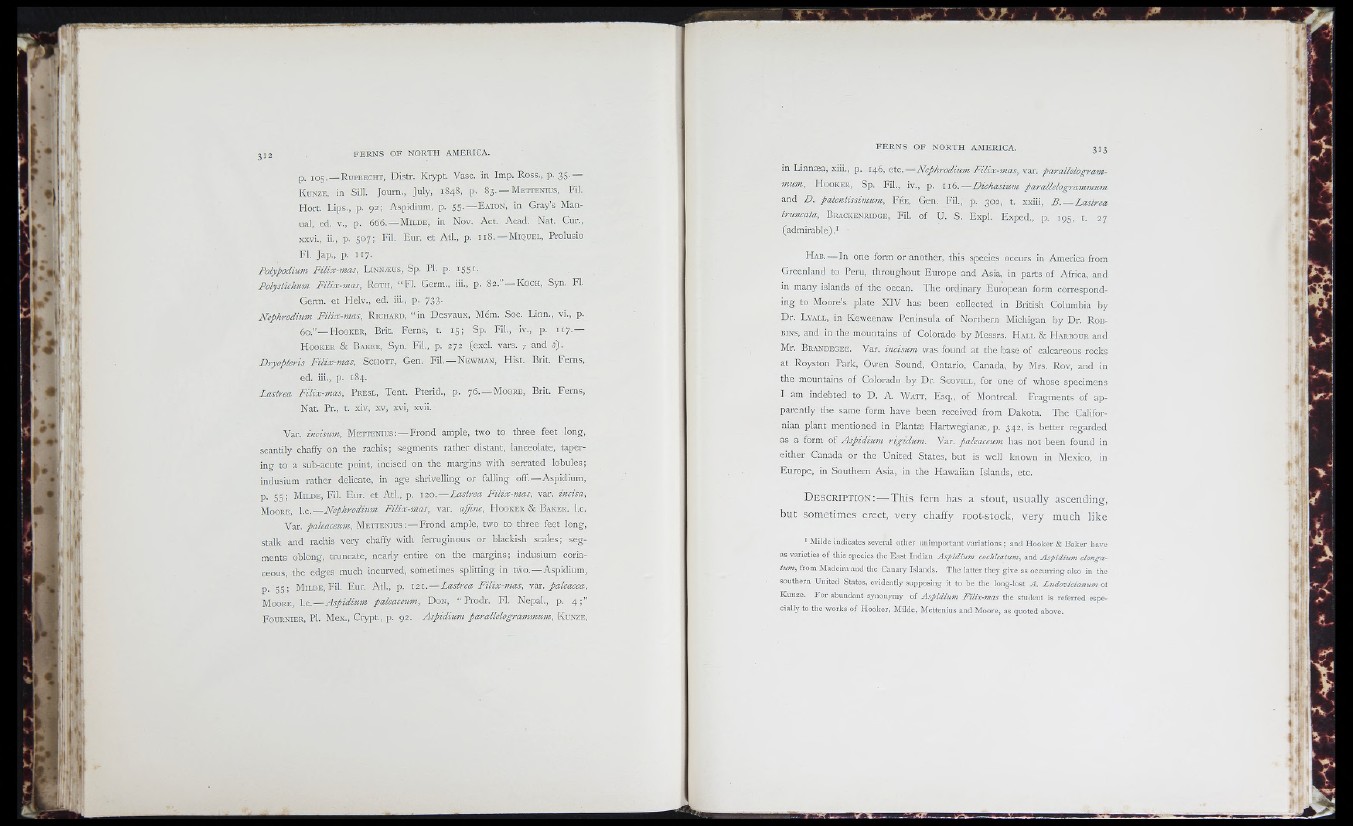
s a
p , 105. — R u p r e c h t , Distr. Krypt. Vase, in Imp. Ross., p. 3 5 .—
K u n z e , in Sill. Journ., July, 18 4 8 , p. 8 3 . — M e t t e n iu s , Fil.
Hort. Lips., p. 9 2 ; Aspidium, p. 5 5 .— E aton, in Gray’s Manual,
ed. V., p. 6 6 6 .— M il d e , in Nov. Act. Acad. Nat. Cur.,
xxvi., ii., p. 507; Fil. Eur. et A t l, p. 1 1 8 .— M iq u e l , Prolusio
FL Jap., p. 117-
Polypodium Filix-mas, L in n æ u s , Sp. PI. p. I 5 5 »*
Polystichum Filix-mas, R oth, “ FI. Germ., iii., p. 82.”— K och, Syn. FI.
Germ, et Helv., ed. iii., p. 733-
Nephrodium Filix-mas, R ic h a r d , “ in Desvaux, Mém. Soc. Linn., vi., p.
60.”— H o o k e r , Brit. Ferns, t. 15 ; Sp. Fil., iv., p. 1 1 7 .—
H o o k e r & B a k e r , Syn. F i l , p. 272 (ex cl vars. y and <5).
Dryopteris Filix-mas, S chott, Gen. F i l — N ew m a n , Hist. Brit. Ferns,
ed. iii, p. 184.
Lastrea Filix-mas, P r e s l , Tent. Pterid., p. 76.— M o o re, Brit. Ferns,
Nat. Pr., t. xiv, xv, xvi, xvii.
Var. incisum, M e t t e n iu s ;— Frond ample, two to three feet long,
scantily chaffy on the rachis; segments rather distant, lanceolate, tapering
to a sub-acute point, incised on the margins with serrated lobules;
indusium rather delicate, in age shrivelling or falling off.— Aspidium,
p. 55; M i l d e , Fil. Eur. et A t l, p. 120.— Lastrea Filix-mas, var. incisa,
M o o r e , I c .— Nephrodium Filix-mas, var. affine, H o o k e r & B a k e r . I.e.
Var. paleaceum, M e t t e n iu s :— Frond ample, two to three feet long,
stalk and rachis very chaffy with ferruginous or blackish scales; segments
oblono-, truncate, nearly entire on the margins; indusium coriaceous,
the edges much incurved, sometimes splitting in two.— Aspidium,
p_ M j ld e , Fil. Eur. Atl., p. 1 2 1 .— Lastrea Inlix-mas, V2X. paleacea,
M o o r e , I.e.— Aspidium paleaceum, D o n , “ Prodr. F I Nepal., p. 4 ; ”
F o u r n i e r , P I Mex., Crypt., p. 9 2 . Aspidium parallelogrammum, K u n z e ,
in Linnæa, xüi., p. 146, etc.— Nephrodium Filix-mas, var. parallelogram-
mum, H o o k e r , Sp. F i l , iv., p. 1 16 .— Dichasium parallelogrammum
and D. patentissimum. F é e , Cen. F il, p. 302, t. xxiii, B . — Laslrea
truncata, B r a c k e n r id g e , F i l of U. S. E x p l Exped., p. 195, t. 27
(admirable).^
H a b .— In one form or another, this species occurs in America from
Greenland to Peru, throughout Europe and Asia, in parts of Africa, and
in many islands of the ocean. The ordinary European form corresponding
to Moore’s plate X IV has been collected in British Columbia by
Dr. L y a l l , in Keweenaw Peninsula of Northern Michigan by Dr. R obb
in s , and in the mountains of Colorado by Messrs. H a l l & H a r bo u r and
Mr. B r a n d e g e e . Var, incisum was found at the base of calcareous rocks
at Royston Park, Owen Sound, Ontario, Canada, by Mrs. R o y , and in
the mountains of Colorado by Dr. S co v il l , for one of whose specimens
I am indebted to D. A. W a t t , Esq., of Montreal Fragments of apparently
the same form have been received from Dakota. The Californian
plant mentioned in Plantæ Hartwegianæ, p. 342, is better regarded
as a form of Aspidium rigidum. Var. paleaceum has not been found in
either Canada or the United States, but is well known in Mexico, in
Europe, in Southern Asia, in the Hawaiian Islands, etc.
D e s c r i p t i o n ; — This fern has a stout, usually ascending,
but sometimes erect, very chaffy root-stock, very much like
I Milde indicates several other unimportant variations ; and Hooker & Baker have
as varieties o f this species the East Indian Asp id ium cochleaium, and Asp id ium clonga-
tum, from Madeira and the Canary Islands. The latter they give as occurring also in the
southern United States, evidently supposing it to be the long-lost A . L u d o v ic ian um of
Kunze. F o r abundant synonymy o f Asp id ium F ilix -m a s the student is )-cferred especially
to the works o f Hooker, Milde, Mettenius and Moore, as quoted above.